COVID-19 put paid to Ellena Swift’s planned programme for Keepa and Lizzie so it’s a good time to give both dogs a refresher course
It might seem like I have plenty of time to plan, lots of equipment and endless ground to train on. While I am lucky to have access to more ground, and I do own dummy-launchers, remote launchers, remote ball-droppers and most shape dummies, I have limited time. Much of my training with the dogs is not planned. It is simply going out into a field with a few dummies and the dogs. I have an idea of what I want to do, but it can be best simply to have a walk round.
My goal for Keepa this season was to win a trial. COVID-19 has put a stop to that. He did have a couple of early runs and more than held his own, getting in the awards. So I am now aiming him at open tests over the summer and team tests. I will keep his training sessions quite short and not too frequent. I do not want to bore him with too much dummy work. Lizzie has come along beautifully in the past few months and I wanted to get her out towards the end of the season for a drive with my other dogs. With those plans thwarted, we will keep her training progressing on the dummies. She has plenty to work on and it’s not the end of the world that she won’t get out on game this year. As a wise man once said, it takes years to train a dog and seconds to ruin it. So there’s definitely no rush.
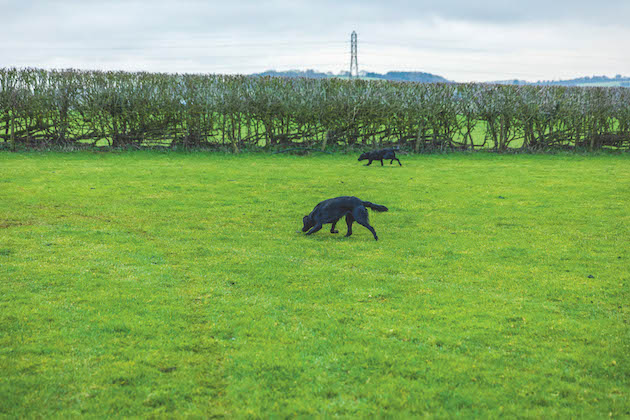
Ellena keeps both dogs off the lead for most of the walk as it is essential they get used to it
With all the above in mind, I’ve been going through normal day-to day-walks but with a bit of training tied in. Everything is done with both dogs in mind, so the walks are right for both the puppy, at novice level, and Keepa at open level. Both dogs do similar exercises with little tweaks to make them either easier or harder depending on the dog. The ground I am going to is a simple grass field. No cover, or hard hunting ground. I take both dogs to the field and start by letting them both out for a quick stretch of their legs, a little run and the opportunity to toilet. The last thing I want is either dog forgetting their work because they are desperate for the loo. It is only ever for a short time because, like most days, I don’t have hours. I am going to start with Lizzie. I don’t want her getting too wound up being made to watch Keepa work over and over.
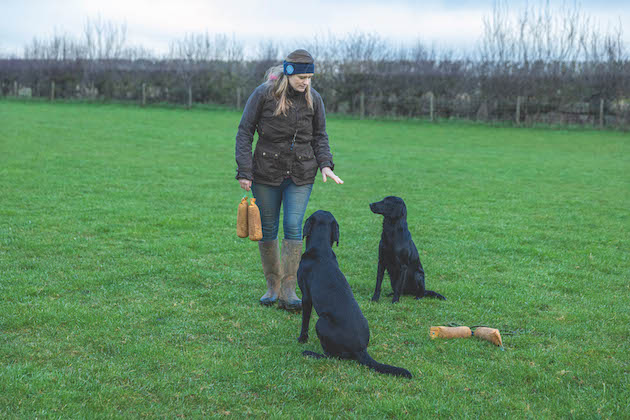
‘A couple of simple marked retrieves for Keepa and Lizzie will help them to get ‘switched on’’
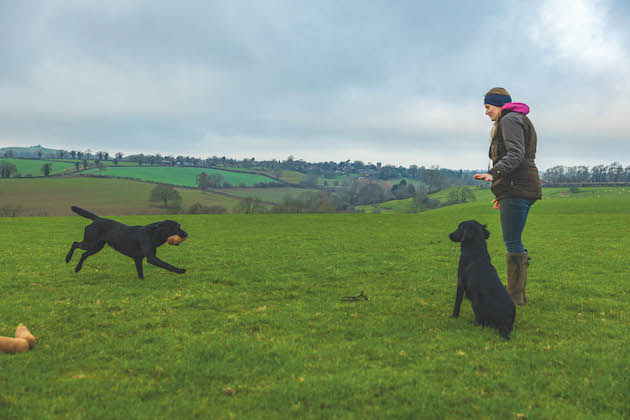
Ellena sends Keepa for the second dummy; she is looking for a nice powerful outrun and for him to hold his line
I begin with a couple of simple marked retrieves. I put out a double mark first and allow Lizzie to pick the first and Keepa to pick the second. These are by no means difficult, but it gives me an opportunity to ensure delivery, steadiness and marking skills are all switched on in both dogs. Lizzie is still a little excited with her delivery so I take some time encouraging her to come in straight to me and either stand or sit while gently holding the dummy. She is quite excitable, so I need to ensure I don’t skip these small but vital skills. Keepa, of course, does his with ease.
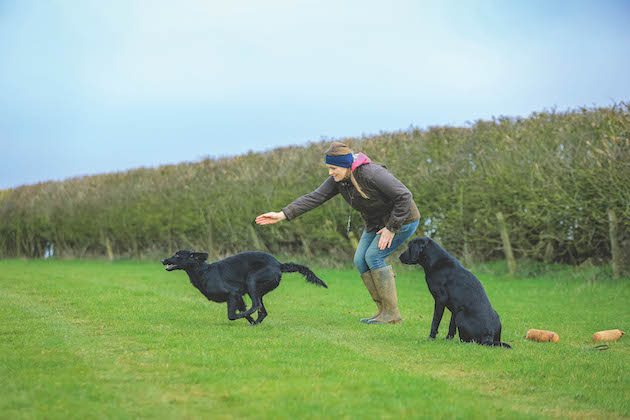
Ellena turns 90 degrees to throw a mark out to the side — a simple distraction for Lizzie before she sends her back for the memory retrieve’
Memory retrieves
Lizzie has not progressed to any form of blind retrieves or difficult handling so is still doing nice simple memories. I walk the dogs down a hedge and leave two dummies. Both dogs know they are there; however, Keepa will not pick his until much later on. I walk them both away and turn 90 degrees to throw a mark out to the side. This is a simple distraction for Lizzie. I send her back for the memory retrieve. It is important that this is not too far for her and that I can see her the whole way. If she starts to lose confidence or go the wrong way, I need to shorten it. I also need to see if she tries to swap. The dummies shouldn’t be so close that she is easily tempted but close enough that she starts to get used to the option of more than one retrieve. If she achieves this retrieve well, I allow her the opportunity to pick the delayed mark.
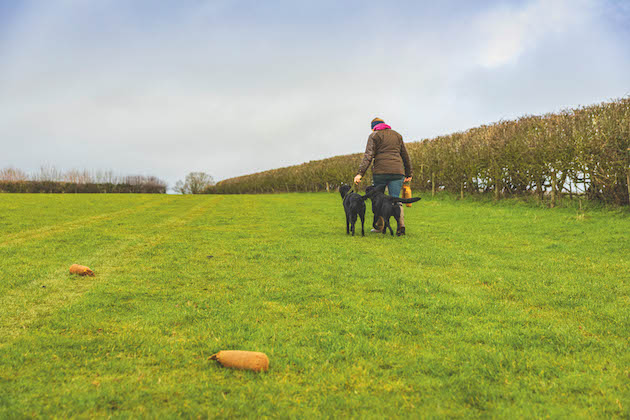
Ellena walks the dogs down a hedge and leaves two dummies — both dogs know they are there
I continue to walk around the field. I keep Lizzie mostly off-lead, but she gets easily pushed out by Keepa on my left side, so I use a lead to help guide her into the correct position next to him. Heel work is boring for handlers and dogs, especially if they are asked to walk long distances. But these are the times to ensure the heel is solid. Shooting can be a long day, so getting the dog used to being content at heel for prolonged periods is a good idea. I now put out more memory retrieves in two new areas. The one memory is still within sight for Lizzie and so not too challenging. The other is a bit more of a stretch for her. I send her for the difficult one first purely because the easier one isn’t such a problem if she begins to forget as she is getting more confident with distance. If she struggles with any of these, I simply take her a few steps closer. In total Lizzie has done five retrieves. The session included steadiness, heel work, watching another dog work and varying distances of memory. Nothing was complicated nor too hard but she came away with more confidence and some nice work. At this stage I put her away.

It is important that the memory retrieve is not too far for Lizzie and that Ellena can see her the whole way
I can stretch Keepa with distance and difficulty. I send him for the second dummy I left out — which, incidentally, was the middle of the three — and hope for a nice powerful outrun and for him to hold his line. Sometimes when doing these exercises, the dog will decide they know where they are going and pull to the retrieve freshest in their memory. If this happens, try to interrupt them and bring them back to start again. If the dog is a bit sensitive, make the retrieve a little easier before sending them a second time as you don’t want to flatten their drive. Once he has picked this, I send him again for the same retrieve. Obviously, there is nothing there now, but I ask him to hunt and hold the area for 30 seconds or so.
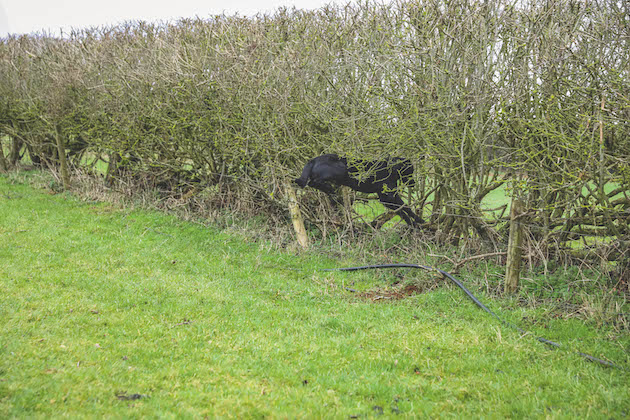
Keepa pushes his way through the hedge where a sneaky blind retrieve is set for him to find
On short grass he finds this harder than in cover as it is pretty obvious to him that there is nothing there. But he has to trust me enough to listen. I then stop him and push him out to the left to pick the memory there. He should cast left nice and bold as he is running to another memory area. Once he has picked that I send him for a third memory. On my walk around earlier I noticed a thin bit of hedge with a small, squashed bit of fence. It makes for a good barrier to push him through, especially as he has already picked from just before the hedge. I cast him out and he naturally wants to hunt where he has already picked from, so before he can set his nose down and hunt, I put in a ‘back’ command as he is running. He understands that this means ‘keep running’. He takes a couple of seconds to work out how to get over the fence and through the hedge but happily pushes his way through where a sneaky blind retrieve is set about 20 yards out for him to find. Again, he hasn’t had loads of retrieves, nor anything too complicated. But this session has done both dogs good, kept their confidence, stretched them at times but continued the fun. Remember that simplicity is often better for us and the dogs. It is rare that we require anything drastically complicated in the shooting field, so don’t overcomplicate the training.



